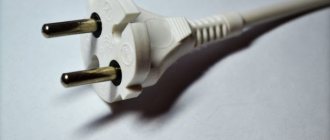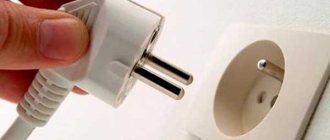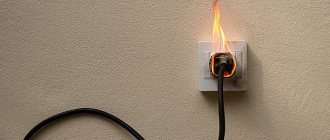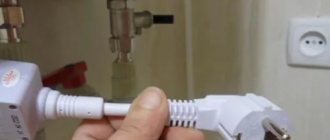First reason. Plug is faulty
The first reason for heating the outlet may not be a malfunction of the outlet itself, but... a malfunction of the plug. The fact is that if the contact inside the plug deteriorates and it begins to heat up, the heat will be transferred to the body of the socket and its contacts. Visually, it may seem that it is the outlet that is heating up, although the reason is the plug.
Read also: Why traffic jams are knocked out
The solution here is simple! Insert the plug into another outlet (preferably in another room) that has not had any problems until now. Turn on the appliance that is powered by this plug.
Wait 5-10 minutes. Remove the plug from the socket and touch the contacts of the plug. If they are hot, then the problem is in the plug; if they are cold, it is in the socket.
In addition, power some powerful device from the first (suspicious) outlet. For example a heater. Wait 5 minutes and feel the plug contacts. Heating will indicate a faulty socket, because... The default plug is OK.
Arrangement of plugs and sockets
The power plug for an electrical appliance is an insulating plastic casing, from which two metal pins protrude, and on the opposite side or side there is a wire cord. The plug body contains wires that are tightly fastened with screw connections to the bases of the pins. Such forks are collapsible and can be repaired or replaced. In the same way, using a screw connection, the wires of the apartment's electrical network are attached to the sockets of the socket. To ensure tight contact in the plug connection with the socket, both must be of the same type. It is unacceptable to insert a traditional Russian plug into a Euro socket.
Eliminate Heat
Before you begin to troubleshoot any problems associated with electrical appliances, you must first stop the current supply to them. To achieve this, you need to turn off the machine, or unscrew the plugs on the electrical panel, after which the cover is removed from the socket, which is secured with a screw in the central part of its body.
If it is noticeable that the contact wires have been exposed to high temperatures, then this is the reason for the heating of the socket. To bring them back to normal, you need to completely remove the socket from its socket, after loosening the screws that secured it. After this, clean the contacts and place them back into the contact clamps, properly tightening the mounting screws. Then the socket is assembled and installed in its place.
How to fix
If the electrical network does not function properly, it becomes an object of increased danger. Operation of the devices is prohibited at the slightest disturbance in operation, especially when the temperature changes or parts melt. You can fix the problem yourself or seek help from specialists.
Problem with the socket
Any work with electricity is carried out after the current supply has been stopped. In a home or room, turn off the machine or unscrew the plugs on the panel. If the terminal in the socket does not press the cable well, then tighten the screw until it stops. If the spring is damaged, professionals advise replacing the part with a new one.
If the brass plates in the device are deformed, then the elements do not fit well. Metal components should be bent and put into the correct mode. If the end of the cable is damaged, the insulating material melts. Carefully remove the soft material, exposing 7 mm, and then insert it into the terminal.
Why does the socket melt?
Forum / Electrical / Why does the socket melt?
Ask a question you are interested in on our forum without registration
and you will quickly receive an answer and advice from our specialists and forum visitors! Why are we so sure of this? Because we pay them for it!
Find out details
Treff
Rating: 4
August 19, 2016at 5:56 am
I noticed that the socket into which the boiler was connected had melted a little. This boiler has been powered from this outlet for more than three years and there have been no such problems before. There is a ground connection on the shield. Why is she melting? Should I replace it or may it not be the cause?
Root
Rating: 127
August 19, 2016at 6:51 am
Oxidation of contacts or weakening of the springs pressing the contacts of the socket to the lamellas of the plug. It can be cured, but it is hardly advisable, given the high power of the consumer (boiler). Replace it so that your soul will be at peace. ps Another possible reason is that the clamping of the wires in the terminal connections of the socket has weakened.
Fifth reason. Rarely, but it happens.
I once had a case:
The client's circuit breaker was knocked out. But at the same time, not a single device was connected to any outlet.
After a long “dance with a tambourine”, I saw that one of the sockets had obvious signs of burning. And only when I removed the socket did the machine stop knocking out.
And the reason turned out to be this: there was such strong carbon deposits around the contacts of the socket (the carbon deposits in the photo below are indicated in yellow) that the surface became conductive. Apparently carbon was released from the plastic.
I measured the resistance between the contacts... It turned out to be only 10 Ohms!!! When this socket was connected to the network, a clearly visible spark jumped across the soot... In short, the soot became a jumper.
So, if the body of your outlet begins to burn, change it without hesitation and quickly!
Video version of this article:
Socket failure
Faulty socket
The socket is checked by connecting to it an electrical appliance with a working plug. After 5-10 minutes, check the temperature of the plug and socket housings. If they get hot, it means that the outlet requires repair, or it does not match the characteristics of the connected device. For example, a powerful device - an electric stove or a vacuum cleaner, but the socket is not designed for high current. If the case remains cold, you need to once again check the plug, which heated up when connected - the reason is that it is broken or that it does not fit into a particular socket.
If the socket is broken, it must be disassembled, inspected, faults identified and eliminated. Possible reasons:
- The contact plate does not press the wire well - the screw needs to be tightened.
- The spring-loaded contact is damaged - the spring is weakened, missing or broken - it is tightened or replaced with a new one.
- The plates that wrap around the electrodes have become deformed - they can be bent and tightened.
- The wire inside the socket has melted - remove the damaged area, remove about a centimeter of insulation and reconnect the exposed tip to the clamping plate using a screw.
- The internal elements of the socket have melted - it is impossible to fix anything here; you need to replace the socket with a new one.
Before performing work related to repairing an outlet, it is necessary to de-energize the apartment completely or only the line that includes the faulty element.
Heating due to wiring
Types of VVG cables
The reasons why a detachable connection heats up are more global and independent of the condition of specific devices. For example, the electrical network may not be designed to handle heavy loads.
- There is wiring in an old house, which was laid at a time when there was no need to operate a large number of powerful electrical appliances: air conditioning, microwaves, etc.
- The wiring was done independently, the calculations were made incorrectly.
- The wiring was laid by workers, but they were not sufficiently qualified and made errors in the calculations.
In these cases, the problem cannot be solved in any other way except by replacing the electrical wiring. It is recommended to lay copper wire of sufficient cross-section.
The contact pair heats up if the plugs are connected through a tee - powered from one socket or inserted into an extension cord with several sockets - connected in series. The load in these cases is summed up, and it may exceed the permissible one.
Broken wire
A plug or socket will overheat if the wire inside is broken. At the fracture site there is a minimum cross-section of the wire, which is not enough for the current of a given strength to flow. The resistance increases, and as the resistance increases, the electrical wiring heats up. In addition, a broken wire is accompanied by microscopic sparking. The sparks further heat the damaged area.
Possible faults
The wires going to the socket are loosely held in the clamps - the fastening is loose.
This most often happens with aluminum wires. Wires made of this metal have an unpleasant property: due to its softness, it seems to “flow” under the pressure created by the clamps when heated! And the first impression from what I saw was that the electrician did not tighten the screws of the wire clamps when installing the socket! Although this may be the case! But I was personally convinced of the fluidity of thin aluminum wires! So: if the wires are copper, tighten the clamp screws with a screwdriver; if the wires are made of aluminum, you need to remove them from the clamps and inspect them.
They can become severely burned, become covered with sagging and even crumble. It was here that the sparking occurred in the socket, which you could hear and even see by the glow of the socket in the dark! Bite off the damaged sections of the wire, carefully remove the insulation from the wires by 7 - 10 millimeters with a knife movement, as when sharpening a pencil, and insert it into place and tighten the clamps. If you do not see any other faults, warping of the case, or cracks, reassemble the socket in the reverse order.
In some types of sockets with a ceramic base, a malfunction occurs due to the loosening of the screws that secure the wire clamp plate to the socket plate. This can be determined by trying to move the clamp with the wire in one direction or another in such an outlet.
If it was not difficult for you to move it, then this is where it warmed itself. Usually, where the plates are heated, their color changes, and the plates in this place may also turn black from prolonged sparking. Here it is enough to tighten the screws holding these plates together to restore contact and eliminate heating of the conductors.
The most unpleasant type of malfunction is warping of the contact plates of the socket sockets.
Most often this happens in sockets where these plates are fixed to a plastic base.
When the plates are heated due to poor contact or a large and prolonged load, the plastic melts and swells. In heated plastic, the contact plates spread apart, causing contact to deteriorate even more as the temperature rises. In such cases, do not engage in “restoration”, but simply change the socket!
There are cases when a socket gets hot and nothing is plugged into it!
And this is not fantasy! This can happen when such an outlet is a pass-through outlet, i.e., the next one is powered from this outlet.
According to the rules of electrical installation, each socket must be connected from a junction box, but quite often there are connections from socket to socket! Such intermediate sockets are called pass-through sockets. Often such sockets are hidden from view by furniture or carpets, and the main load is taken by the final socket. In this case, it is necessary to remember that all the power that the final socket produces also passes through the intermediate socket! And there may be loosely clamped contacts or aluminum wires (I already wrote about the fluidity of aluminum wires)! Disassemble the socket, check the integrity of the wires as described above, tighten the contact screws and assemble the socket.
What should you do if you have disassembled the socket, made sure that it cannot be restored, and there is no new one in stock?
My advice: don't put it back! Carefully insulate each wire with electrical tape, hide the wires in the socket and immediately go to the store for a new socket. You can take the old socket with you to the store for a sample. While shopping, you can turn on everything in the electrical panel that was turned off, and before installing the purchased outlet, turn off the power to the apartment again.
It has been noticed: if you reassemble and put a faulty device in its place, someone will definitely get into it, no matter how many times you warn everyone! And few people risk sticking a plug into protruding wires; the instinct of self-preservation kicks in! And the sight of a torn socket forces you to finish the job!
Main reasons
There may be several reasons why the outlet gets hot; the most typical situations can be defined as follows:
- the fork gets hot;
- The socket gets hot;
- problems with contacts in the socket mechanism, poor contact;
- the reason is in the wiring;
- unacceptable current and power values.
These points should be discussed in more detail. However, before this, it is worth mentioning that sockets and plugs should not get hot. A slight heating under load is allowed, but it should be insignificant. If you notice heating without load, when the plug is not in the socket, then the cause should be identified and eliminated as soon as possible.
Useful tips
If you decide to disassemble the outlet, then this should only be done on a completely de-energized network. Turn off the power supply at the input circuit breaker, and then begin inspection and disassembly. The same will be true when carrying out repair work.
It is important to consider that securing the cable to the contacts should be done securely and tightly. If the contacts on the socket and plug are severely damaged, then the only option is to replace them with new products.
In a situation where you cannot independently determine the cause of overheating and eliminate it, you should call a specialist to your home who will solve the problem. It is not worth leaving it without a solution; it can be dangerous due to failure of connected devices and even a fire.
Wiring as a cause of heating
A modern apartment is characterized by a large number of electrical consumers that were not provided for in the calculations of the wiring laid during the construction of the house, which dates back to the last century. In most residential buildings in Russia, an aluminum cable with a cross-section not exceeding 2.5 mm is installed, which allows a total load of 20 A and 4.4 W. Such characteristics may not be enough if several high-power consumers are turned on at once, for example, an electric kettle, a thermal curtain and a washing machine with a heating element.
The permissible load on one contact pair can be determined based on the results of measuring the diameter of the conductor core and calculating the cross section. The calculation algorithm is discussed above when describing the diagnosis of plug problems.
Insufficient cross-sectional area of the power wires coming to the sockets can also be the reason why the plug in the socket heats up. To prevent unfavorable developments, you should:
- carry out a complete replacement of wires in the entire apartment, giving preference to conductors with copper conductors;
- distribute the load evenly across the available quick release connections and limit the maximum load. It should be taken into account that sockets connected in series or connecting several splitters into one socket place a load on the supply wire corresponding to the total power of the consumers.
Why does the socket on the washing machine get hot?
08/31/2015 Contents
In order to prevent short circuits, burnt wires and thereby prevent damage to household electrical appliances, it is necessary to regularly check the condition of the sockets. After all, it is always easier and cheaper to prevent a minor breakdown than to later pay for your sluggishness not only with money, but possibly with your health.
If the outlet is heating up, then you should not hope that the reason for this will simply disappear, without outside intervention.
Heating of the outlet can be caused by various reasons, including:
- Excessive power of electrical appliances connected to the outlet.
- Unstable contact of the plug inside the socket.
- Malfunction of the connectors inside the socket.
- The contact of the socket clamp is not tight enough.
How to check for lack of voltage.
I ask you not to skip this section!!! There is one nuance that only electricians know about.
Before you begin repairing an outlet, it must, of course, be turned off (with the appropriate circuit breaker in the panel). After this, use the voltage indicator to check the absence of voltage.
Surely, many people know how to use it: touch the metal contact on the top of the indicator with your thumb, and touch the live part of the socket with the working surface (spatula). If the light is on, it means you have touched a surface on which there is a dangerous potential (phase), if it is not on, it means there is no voltage there and you can touch it with your hands.
But!!!
Before using the indicator, you need to make sure that it is CORRECT! It is very important! Suddenly, yesterday he fell on the concrete floor and something in him deteriorated. And without knowing this, you check that there is no voltage, the light doesn’t light up, you think that you can touch it with your hands and then... BAM! It's good if everything goes well...
Therefore, first test the indicator on the outlet that is known to be turned on. Make sure that when you touch the phase contact, the light bulb lights up reliably. And only then check the disconnected outlet to ensure there is no dangerous voltage.
If the plug from the washing machine melts in the bathroom, what should you do?
Another common problem with heating plugs is that they become heated in the bathroom. As a rule, the fork is heated during intensive operation of the washing machine - when the water is heated by the TEN. It is important to pay attention to a number of reasons:
- Quality socket and plug.
- The socket is moisture protected.
- Oxidation of wires both in the socket and in the plug.
- Washing machine wire cross section.
- Specific load on wiring in the apartment as a whole. In some cases, even old wiring can handle the load. It is just important not to turn on all household appliances in the house at once.
If a simple socket without moisture protection was installed, then over time there is the prospect of oxidation, which leads to heating of the equipment. You should also clean forks or carriers if they are used in the bathroom: dust and dirt are undesirable companions in the operation of the washing machine.
Symptoms of the problem
Under normal conditions, network devices should not become hot. If you touch the plastic while electrical appliances are running, the plug, cable or socket will always remain cold. Even a slight increase in temperature warns of problems in functioning.
At the first stages, the processes inside the devices go unnoticed by the user. A person pays attention already when an unpleasant smell of burning or sparks appears. Upon contact, the element produces an electric shock. If the outlet gets hot, there is a problem with the design.
Symptoms of device malfunction Source zen.yandex.ru
If changes are ignored, the device damages the fuses of switched on electrical devices, which leads to the combustion of electronic chips. Automatic protection in the shield is supposed to protect the equipment from troubles, but it wears out over time. If neglected, the problem will cause a fire.
Features of choosing thermostats for the cellar
In the cellar where fruits, vegetables and preserves are stored, the primary task is to maintain a suitable air temperature. During frosts or warming, temperature fluctuations can be critical for supplies. To protect them, you should get a thermostat with an air temperature sensor for the cellar. Due to its efficiency and adaptability to long-term continuous operation, such a device will be the optimal solution for creating the necessary indoor microclimate.
In the cellar, uneven temperature distribution is especially important, so it is important to choose the right location for the sensor. It should be located:
- at an average, not too large and not too small distance from the heater;
- low – optimally at a height of 3-5 cm above floor level;
- close to vegetables, fruits, canned food and other products stored in the cellar.
Load determination using wire cross-section
The conductor area needs to be known. This way the wiring capabilities are determined and the load is controlled.
To determine how much a contact pair can withstand, it is necessary to take measurements:
- Find out the diameter of the core, for example, using a caliper. Let's say the wire is aluminum, thickness - 2.3 mm.
- The cross section is found by the formula: S=0.785*D². S - cross-section, D - diameter, 0.785 - coefficient obtained by dividing the TT value (grounding system) by 4. That is, S = 0.785 * 2.3² = 4.15 mm.
- Now the obtained value must be compared with those given in Table 1. These are standards for domestic or industrial conditions, depending on voltage. Let's take a cable used at home.
- For 4.15 mm, the exact value of current and power was not found in Table 1; you will have to calculate it. You need to find out the specific values per 1 mm². The cross section is between 4 and 6 mm. Therefore, the specific current (I) and power (N) are found as the difference between the maximum and minimum values in this interval. The latter can be viewed in the tables. The resulting figure is divided by the difference in the sections of the interval. That is, specific I=(36-28)/(6-4)=4 A/mm², specific N=(7.9-6.1)/(6-4)=0.9 W/mm².
- Specific parameters are multiplied by the difference between the found section and the minimum tabulated value of the interval. The resulting figure is added to the minimum current or power of the interval. The required I=(4.15-4)*4+28=28.6 A, N=(4.15-4)*0.9+6.1=6.24 W.
The found values must be compared with those specified in the instructions for the devices being switched on. If the required parameters are greater than those found, the wiring cannot cope and causes heating. It is better to choose a high-quality copper cable with a thickness of 4–6 mm.
Knowing how to fix minor breakdowns will not be superfluous in the household. If you understand the reasons for the violation, you can not aggravate the situation, but correct it in time.
Troubleshooting and Troubleshooting
Checking the AMS for malfunctions and repair work are carried out comprehensively. They are carried out by first turning off the device and removing things from the drum. It is worth inspecting the wires for kinks and breaks, as well as the program on which the wash is performed.
If the washing machine does not heat the water, the device may display an error during operation and then interrupt the wash.
Checking the Thermostat
You can inspect the heating sensor and resolve the malfunction as follows:
- Unplug the washing machine and disassemble it.
- Remove the heating sensor.
- Use a multimeter to check the resistance of the part.
- Heat the water and lower the thermostat into it, measure the resistance again.
- If there is a large difference between the indicators, the heating sensor is working properly.
- If the difference between measurements is insignificant, the part should be replaced.
Advice! Remember the sequence of fastening the case or take a photo of the elements.
Testing and replacement of heating elements
If your household washing machine does not heat cold water at all, there is a risk of a heater malfunction. It breaks due to constant load, scale from hard water or voltage fluctuations.
To check the heating element, it is recommended to ring it using a multimeter
To work you will need a multimeter:
- The SMA is disconnected from the outlet.
- The water drains through the filter at the bottom.
- The back wall of the device is removed.
- The heating element is checked. The multimeter is set to 200 Ohm, and then the phase and zero resistance are measured, taking into account:
- normal results - from 24 to 50 Ohms;
- circuit open (heater malfunction) - no resistance;
- the presence of normal resistance, but no heating - the difference between the central conductor of the heating element and the body is at least 1 Ohm;
- resistance below 1 Ohm - the heater is broken.
When purchasing a new heating element, the part is selected for a specific machine model.
- The front or rear panel is disassembled.
- The wires are separated from the old heater.
- The heating element is unscrewed and removed.
- A new heating element is installed and assembly is carried out in the reverse order.
Important! When removing the front part of the case, you must also remove the control panel
Identifying Software Center Failures
The programmer malfunctions due to heater breakdowns, manufacturing defects, mains voltage drops and broken wire contacts.
The software module can be repaired in rare cases by restoring and flashing. The part is mostly replaced.
In this case, independent repair is contraindicated; it is better to contact a specialist.
Checking for scale and removing it
Salts in hard water and rust from water supply lines lead to plaque on the heating element. After inspecting the details:
- Place the heater in the citric acid solution for 30 minutes.
- Clean the product with special products.
- If the machine has been used for more than 7 years, replace the heating element.
- For prevention, add anti-scale compounds, run SMA with hot water, adding citric acid, or install a filter.
Important! If you do not clean the heating element from scale, it will quickly break, washing will be prolonged, and electricity consumption will increase.
Checking and repairing the pressure switch
It is advisable to carry out the work together with replacing or cleaning the heating element as follows:
- Unplug the washing machine.
- Unscrew the back of the housing or the front wall together with the control panel.
- Remove the heating element, separating it from the wires.
- Inspect the pressure switch relay.
- If there is small debris, remove the tube and blow it out.
- Check the part for tightness and quality of heating.
The water level switch may be clogged with lint or small debris.
If there is no damage, the heating relay is put in place, and the equipment is assembled in the reverse order.
Checking the connection
All the parts are in good working order, the program mode is selected correctly, but why does the household automatic washing machine still not heat running water? You should check the connection. If the water supply pipes are not connected correctly, do the following:
- Disconnecting the SMA from the network.
- Checking hoses.
- Screwing the complete hose onto the outlet on the right side on the rear wall.
- Tighten the plastic union nut ½ turn.
- Diverting the second end of the hose to the water supply by inserting a tee.
- Cleaning the filter and reinstalling it.
- Installation of a ball valve with pre-winding threads.
- Install the drain hose at a height of 0.5-1 m from the floor.
Important! The drain must be carried out through a siphon of a sink, sink, into a bathtub or sewer
The water heater plug is getting hot
Tighten it, and if the heating goes away, you don’t have to change the socket.
Anatoly Shabalin
Rating: 34
August 19, 2016at 7:58 am
I agree with what Root said. But it is also important what kind of outlet it is. More precisely, what load is it designed for?
And the body material. Look for one with a ceramic body. They are usually more powerful. And of course not Chinese.
vitas64
Rating: 85
August 19, 2016at 8:37 am
The socket melts because too much load is passing through it. Over time, the contact plates or springs weaken and carbon deposits form on them. The socket needs to be replaced or the contacts bent and cleaned, but I would install a two-way breaker instead of the socket.
VLAD
Rating: 67
19 August 2016at 21:15
The problem most likely was in the contact plates or springs; they weakened over time and the contact began to deteriorate. Therefore, the socket began to melt. It would be better to replace it with a new one for reliability.
Fourth and fifth reasons. Contacts.
These two reasons are the most common.
Check whether the screws marked with number 1 are tightly clamped. By the way, the contact will be better if the connected wire is placed under a ring-shaped screw (as in the photo).
Pay attention to how compressed the contacts, indicated by the number 2, are. If the contacts of your socket do not include a spring (3), the “cheeks” of the contacts (2) may not tightly clamp the contacts of the plug. As a temporary measure, you can press these same cheeks together. But soon, they will unclench again and... “our song is good, start over.”
Therefore, take the time and resources to replace the socket with one with springs.
Why does the wire in electrical appliances and extension cords get hot?
Heating of the wire in electrical appliances is caused by a disproportionate ratio of the cross-section of the wire and the strength of the current that flows through it. If the wire is thin and the appliance is powerful, for example an electric kettle or electric heater, the thin wires will heat up. The same thing happens if a device with a cable of sufficient diameter is connected to an outlet using a household extension cord.
The socket on the washing machine gets hot
If the outlet into which the washing machine is connected heats up, this phenomenon may be caused by the following reasons:
- Disproportionate power of the machine connected to the outlet - on the body of the outlet it is indicated what power it is designed for. If the numbers don't match, it will inevitably cause overheating.
- Poor contact between the plug and the socket is observed when connecting a Soviet-style plug to a European socket. The electrodes of the Soviet plug are a millimeter thinner, and therefore the contact density is less.
- The socket itself is faulty. Visually it can be diagnosed by the presence of cracks and melted areas.
- Weak socket contact blades. Due to careless use, the clamps may become loose.
None of these reasons will go away on their own. Measures should be taken to eliminate it.
The water heater plug is getting hot
A water heater is a powerful device. A boiler, for example, has a power of 1.5 to 2.5 kW, and its amperage reaches 12 A. If the plug, socket or cable becomes so hot that it is impossible to touch it, the possible reasons are the following:
- the cable has a cross-section of less than 2.5 mm2;
- there is poor contact of the plug in the socket;
- the water heater is connected via an extension cord;
- A low-quality or old-style socket is installed.
Heating of the boiler plug is acceptable, but the temperature must be within normal limits. A hot, but not scalding body without any traces of melting is not a cause for concern.
Briefly about electrical safety
If, when operating electrical appliances, the socket sparks when the plug is inserted or it heats up, you must do the following:
- disconnect consumers from the problematic outlet and protect it from use;
- if smoke appears from the contact device, it is necessary to turn off the corresponding bag on the distribution panel;
- exclude the inclusion of an electrical appliance whose plug heats up;
- limit the load on the outlet into which the device with the heating plug was plugged in;
- seek professional advice and diagnostics if your own skills and experience do not allow you to solve the problem.
When you connect the plug to the socket, it heats up: probable causes of the malfunction
There are many devices that are powered by current in the home or office. If in the office there are computer equipment and office equipment, then in the living room there are no less such devices. Often, when you plug in a boiler, refrigerator or washing machine, there is a malfunction in the operation of electrical devices, they begin to heat up, and after a while you can even hear a slight crackling sound, and an unpleasant smell of burnt rubber or plastic is felt in the air. There are several reasons for this malfunction. Depending on what is heating up - the plug or the socket, the method of troubleshooting is determined.
Faulty plug
However, such manifestations are not always characteristic of the device; often the malfunction goes unnoticed, until spontaneous combustion occurs. Therefore, timely detection of plug failure is the key to safety in the home.
You can quickly determine what is faulty – the electrical socket or the plug itself – using a simple experiment:
- Initially turn on the device whose plug heats up in a specific outlet.
- Test the same outlet with other electrical appliances.
- If only one device in the plug heats up, while the others are working properly, then the problem is in the plug. If the plugs connected from the appliances to the socket do not work properly and heat up, the reason is in the wiring of the room or in the socket.
- improper operation of electrical devices;
- contact burnout;
- high load (as a rule, a characteristic feature for carriers and water heaters);
- incorrect cross-section of the wire if we are talking about a DIY extension cord;
- sudden surges in the network that led to a malfunction;
- low-quality device, materials (cheap plugs from China) that were used independently or by the manufacturer.
Socket failure
If the reason for the heating of the appliance plug is a malfunction of the socket, then when the device is plugged into this socket, it will overheat. Fault detection options:
- Visual inspection: external plastic defects, melting, heating - the result of a malfunction.
- Testing an electrical device by plugging it into a given connector. If the plug glows and the plug becomes hot only in this place, the cause of the breakdown is in the socket.
- The load current is higher than the declared capabilities of both equipment and wiring. The result is increased load, overheating.
- Violation of conductor insulation. Failure to comply with the device installation technology is a common and probable cause of overheating.
- Problems with contacts - oxidation or weakening. The solution to the problem is to strip and tighten the contacts, and further isolate them.
- Loose contact systems are also a common cause of malfunctions. Incorrect operation, pulling out plugs of electrical devices with sudden movements from a tight socket entails negative consequences.
Heating due to wiring
- High load on wiring. A common cause is in old panel houses with aluminum wiring.
- Small wire cross-section.
- Incorrect cable routing.
- The service life has expired.
- Improper insertion of copper wiring from old aluminum wiring.
Solving problems with a collapsible fork
A removable fork can usually be repaired. To eliminate the malfunction, initially the wire is disconnected from the device, then the bolts located either in the center or on the sides of the plug are unscrewed
What should you pay attention to initially?
- Bolt fastening. If it is weak, it is worth tightening and fixing the bolt.
- Burnt wires should be cleaned, a small section of insulating material should be cut off, and the insulation should be re-insulated with electrical tape.
- Oxidation of wires and troubleshooting in this case is also done by stripping and insulating, tightening the brands.
Why does the plug in the extension socket get hot?
If the outlet on the extension cord from the store begins to heat up, you should pay attention to the degree of calculated load on the wire. As a rule, the extension cord includes not only devices, but also tees with adapters
In this case, the adapter simply cannot cope with the load.
Causes of sparks in an outlet
A blown electrical outlet may cause a fire or seriously damage the plug.
The purpose of the plug socket is to connect the plug with the electrical network. During normal operation, current flows through the contacts with minimal heat generation. In some cases, when inserting a plug into a socket, a breakdown occurs. The higher the power of the device being turned on, the more intense the sparking and crackling. The temperature of the electric arc is very high, and a characteristic smell of molten plastic appears.
Sockets crack for several reasons:
- Exceeding the power for which the electrical installation product is designed.
- Long service life and natural wear of connectors.
- Loosening of contact clamps.
- The plug connection parts are manufactured to different standards.
- The product supplied was of low quality and had a short service life.
If the socket shorts out when you turn on electrical appliances, you should temporarily use another power point. There are several factors leading to failure.
Overload
Rated current on the socket body
Electrical installation structures are designed for a certain rated current. The parameter is indicated by the manufacturer on the panel. Before the advent of powerful household appliances, it was sufficient to install a product with a current of 6-10 A, now the figure is 16 A. For three-phase networks, the parameter is at least 32 A. Exceeding the rated current leads to heating of metal parts. High power of equipment increases the load on electrical wiring. For safety reasons, it is made of cable with copper conductors.
The formula P=IxU will help you calculate the permissible power, where P is power, I is current, U is voltage. For example: P=10×220=2200 (W). A socket with a rated current of 10 A can withstand connecting devices with a total power of up to 2.2 kW.
Worn connectors
The result of a worn socket connector
The contact terminals bear a high load. They are designed for a specific resource. After several years of use, if you frequently insert and pull out the plug, the contact plates will loosen. They do not fit tightly around the pins. Intermittent contact causes crackling noises and sparks. The socket begins to warm up and hiss when the metal is covered with a layer of oxide. The process arises from moisture. The springing properties of oxidized metal are reduced. To extend the life of the device, it is worth turning off the devices with a special button, and not by pulling out the plug.
Loosening screw terminals
Socket contact screw terminals
If you hear a cracking sound in the outlet, the cause may be loose screw connections. The situation arises due to heating and deformation of the metal. The process occurs in all electrical installation products, so experts recommend carrying out preventive tightening of contacts once every 2 years. Aluminum wires are checked more often
When pulling, it is important not to pinch the core, otherwise it will become deformed. One of the mistakes that unskilled installers make is using a long screw.
The fastener rests against the wall and does not allow the contact to be properly tightened.
During installation, it is advisable to wrap the wire in a loop around the screw. This method significantly increases the contact area. Modern devices are manufactured using screwless technology. Their installation is simplified and preventive maintenance is not required.
Mismatch of selected plug parts
a) Soviet standard fork, b) Shucko fork
Plugs and sockets are manufactured to standard sizes. In Russia, two designs are used:
- The European Type C or Europlug is a plug with two parallel round pins. The distance between them is 19 mm, diameter 4 mm.
- Type F or Schuco - plug with protective contact, grounding. It is widely used in Europe, popular in Russia and the CIS countries. The plug pins have a diameter of 4.8 mm.
Also, due to poor contact with plug C, the socket intended for type F plugs sparks. The connection is acceptable for low-power devices, but overheating occurs with high power consumption.
Poor device quality
Inexpensive electrical installation products quickly become unusable. They use thin plates, unreliable fastening, and the contacts are loosely tightened. Chinese products have low cost due to low quality. It does not correspond to the declared power and quickly becomes loose during operation. Due to the high load, the sockets hiss and fail after a maximum of 2 years.
a) Original Legrand socket, b) Counterfeit
High-quality products in the budget segment - products from Vico and Makel. European brands Legrand and ABB have inexpensive series.
Why do we need sockets with a thermostat for heaters?
The temperature in the room is usually set by the heater. However, the main inconvenience in its operation is the need to regulate the temperature during the heating process. That is, when a comfortable temperature is reached in the room, the heater has to be turned off, and when it becomes cool again, the heater has to be turned on.
The problem of maintaining a comfortable temperature on a constant basis is easily solved if you buy a thermostat for the heater. With this device you will not have to adjust the operation of the heating device every now and then - the thermostat will do it for you.
Models of thermostats with remote control are convenient to use.
Comfortable temperature conditions 24 hours a day
Regulating the air temperature without direct control of the owner of the room is convenient, simple and, with the help of modern technologies, possible. It is enough to select the desired thermostat, which can be installed either directly into the heating element or into an outlet, controlling a specific object.
The selection parameters are price, quality, manufacturer and provision of comfort 24 hours a day.
The rosette temperature controller is the most popular, as it does not require special installation, is mobile and easy to operate.











